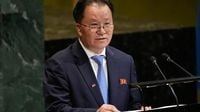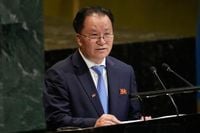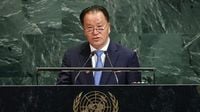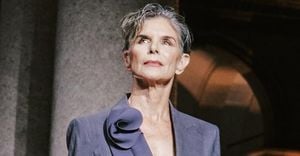In a rare and closely watched appearance at the United Nations General Assembly in New York on September 29, 2025, North Korea’s Vice Foreign Minister Kim Son Gyong made it clear to the world that his country has no intention of relinquishing its nuclear weapons. Addressing the 80th session of the Assembly, Kim doubled down on Pyongyang’s long-standing position, calling its nuclear arsenal essential for maintaining a "balance of power" on the Korean Peninsula, especially in the face of what he described as escalating military threats from the United States, South Korea, and Japan.
"We will never walk away from this position," Kim declared, as reported by the Associated Press. He insisted that North Korea’s nuclear program, now enshrined in its constitution, is a vital deterrent against what he called a "growing threat of aggression" posed by U.S.-led military exercises in the region. According to Kim, these exercises "are breaking all the previous records in terms of scale, nature, frequency and scope," a sentiment echoed in coverage by The Associated Press and other major outlets.
Kim’s speech, while stern, was notably more measured than some of North Korea’s past rhetoric on the world stage. There were no direct barbs aimed at U.S. President Donald Trump, nor the personal insults that have occasionally punctuated North Korean statements in previous years. Instead, Kim criticized unnamed "hegemonic forces" and an "indiscriminate tariff war," reserving his sharpest words for the military maneuvers he said threaten the peninsula’s stability.
It was the first time since 2018 that a senior North Korean diplomat had attended the annual UN General Assembly gathering, signaling, perhaps, a subtle shift in Pyongyang’s diplomatic approach. Yet, the core message remained unchanged: North Korea’s nuclear weapons are, in Kim’s words, the reason "the balance of power on the Korean Peninsula is ensured." He warned the Assembly not to be complacent about the absence of world war over the past 80 years. "We should pay due attention to the fact that the inducible threat has persisted and is now becoming more serious, and take measures accordingly," Kim said, as quoted by The Associated Press.
On the other side of the DMZ, South Korea responded with a markedly different vision. President Lee Jae Myung, speaking at the same high-level meeting just a week earlier, called for a "new journey toward peaceful coexistence and shared growth on the Korean Peninsula." Lee’s administration, which has faced rising tensions with the North since taking office, has argued that recent trilateral military exercises with the U.S. and Japan are a necessary response to Pyongyang’s expanding nuclear and missile arsenal. Still, Lee extended an olive branch, stating, "The first step will be to restore broken inter-Korean trust and shift to a stance of mutual respect." Kim Son Gyong, however, did not address this overture in his own remarks.
The UN Security Council, for its part, has repeatedly demanded that North Korea halt its nuclear weapons and ballistic missile programs. Despite these calls, Pyongyang has continued to expand its arsenal, citing security threats and the need for self-defense. The current standoff, as reported by The Associated Press, reflects a broader stalemate that has persisted for years, punctuated by moments of both hope and heightened tension.
Amid these diplomatic maneuvers, there are new signs of possible movement on the U.S.-North Korea front. Since returning to office in January, President Donald Trump has made several public statements expressing hope of restarting talks with North Korean leader Kim Jong Un. The two leaders famously met three times between 2018 and 2019, but negotiations collapsed over U.S.-led sanctions and North Korea’s refusal to abandon its nuclear program. Since then, Kim Jong Un has largely shunned direct diplomacy with Washington and Seoul.
Yet, just last Monday, Kim Jong Un reportedly said he still has "good memories" of Trump but urged the U.S. to drop its precondition that North Korea give up its nuclear arms before talks can resume. According to South Korean Foreign Minister Cho Hyun, President Lee has asked Trump to act as a "peacemaker" and use his influence to bring North Korea back to the negotiating table. Cho told the Associated Press, "Trump expressed his willingness to be engaged with North Korea again."
With Trump expected to visit South Korea next month for the Asia-Pacific Economic Cooperation (APEC) summit, speculation is swirling about a possible meeting with Kim Jong Un. The U.S. president is also expected to meet with Chinese leader Xi Jinping during the summit, raising the stakes for regional diplomacy. While nothing is set in stone, the prospect of renewed dialogue has caught the attention of governments and analysts across Asia.
North Korea’s diplomatic activity has not been limited to the United States and South Korea. In recent years, Pyongyang has deepened its ties with both China and Russia. The Associated Press reports that North Korea has supplied combat troops and ammunition to support Russia’s war effort in Ukraine, marking a significant expansion of its military partnerships. Earlier this year, Kim Jong Un and Xi Jinping held their first summit in more than six years, pledging mutual support and enhanced cooperation. That meeting followed a historic joint appearance by Kim, Xi, and Russian President Vladimir Putin at a massive Beijing military parade commemorating the end of World War II.
Just a day before Kim’s UN speech, the foreign ministers of North Korea and China met in Beijing, agreeing to deepen their bilateral relationship and resist "hegemonism"—a thinly veiled reference to their shared opposition to U.S. influence in the region. The Associated Press noted that this diplomatic push reflects Pyongyang’s ongoing strategy to balance relations with its powerful neighbors while maintaining its nuclear deterrent.
For many observers, the developments at the UN and beyond highlight the persistent complexity—and volatility—of security on the Korean Peninsula. North Korea’s insistence on retaining its nuclear arsenal, despite international pressure and offers of dialogue, underscores the deep mistrust and strategic calculations that continue to drive policy in Pyongyang. Meanwhile, South Korea’s calls for peaceful coexistence, and the possibility of renewed U.S.-North Korea talks, offer a glimmer of hope—however tentative—for a reduction in tensions.
As world leaders look ahead to upcoming summits and potential diplomatic breakthroughs, the fundamental questions remain: Can the current deadlock be broken, and is there a path toward lasting peace on the peninsula? For now, all eyes are on the next moves from Pyongyang, Washington, and Seoul—each side wary, each side waiting.






